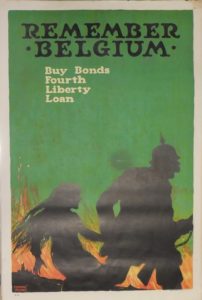During our extended closure we approached UT faculty and staff with a question. We asked them to tell us which object in our collection had the biggest impact on their classes, their students, or their own exploration within the museum.
 Marina Maccari-Clayton, a Distinguished Lecturer in History at UT, chose one of several propaganda posters from World War I that are held in the McClung’s collection. The posters, including the one she focuses on, were designed to convince the American public to support the U.S. war efforts abroad by purchasing Liberty Bonds.
Marina Maccari-Clayton, a Distinguished Lecturer in History at UT, chose one of several propaganda posters from World War I that are held in the McClung’s collection. The posters, including the one she focuses on, were designed to convince the American public to support the U.S. war efforts abroad by purchasing Liberty Bonds.
Dr. Maccari-Clayton states: “Students in my course really appreciated the opportunity to see the propaganda posters in person. A poster that resonated with many of them was the one with the Remember Belgium caption, depicting the silhouette of a young girl with flowing hair being dragged by a soldier wearing a spiked helmet while flames burn in the background.”

Poster, Ellsworth Young, 1918, Lithograph, Donated by Paul Fink, 1962.33.11.
Early in the first World War, the German occupation of Belgium was often used as the subject for these posters. The invasion was highlighted by an intense amount of violence committed against Belgian civilians by the German army. (This episodic documentary succinctly presents the earliest period of the war should you want to know more. Please note that it presents difficult imagery.)
This particular poster was designed by illustrator, Ellsworth Young. In it, a soldier’s silhouette features the iconic spiked helmet of the German army that the British and American public associated with atrocities. He is dragging off a small woman – or girl – making an explicit link between the invasion and assault. The viewer is left to imagine the worst.
Dr. Maccari-Clayton continues: “This is a powerful image per se, but it also connects to the topic of late 19th and early 20th-centuries European imperialism in Africa, and an excerpt that students read from Adam Hochschild’s book discussing the ‘Great Forgetting’ of the atrocities that took place in King Leopold’s Congo Free State. Students read about the way World War I propaganda contributed to that forgetting, but the visual impact of the poster makes the understanding of that connection more immediate.”
Dr. Maccari-Clayton is referring to Leopold II (full name Leopold Lodewijk Filips Maria Victor) who was the Belgium king from 1865 until his death in 1909. Leopold oversaw the colonization and annexation of the Congo Free State. The colony was privatized by Leopold, who was the only imperialist to make such a bold move, so he could grow personal wealth through ivory and rubber. Belgians extracted these materials through notoriously horrific forced-labor practices, violence, and genocide against the Congolese. Leopold’s practices were mimicked by French, British, and Germans who were also overseeing colonies in Africa, but Belgium’s practices remained the most brutal.
The “Great Forgetting” mentioned by Dr. Maccari-Clayton refers to efforts to erase, or at least downplay, the atrocities committed in the Congo by Leopold and Belgium while he was in power. Even during his lifetime, Leopold became unpopular and disliked – though more for his domestic agenda and offensive personal behavior than for his actions in the Congo. As soon as he died, Belgium made great efforts to minimize his history and cover up the genocide, by instead focusing on Leopold’s public domestic infrastructure projects. This orchestrated “forgetting” makes the artistic choice to implore viewers to “Remember Belgium” particularly poignant in this poster, which was created only nine years after Leopold’s death.
Dr. Maccari-Clayton draws a complicated, but clear, trajectory through this object lesson. She guides students from Leopold’s vicious legacy, to the re-envisioning of Belgium as a country of innocence, to the horrors of World War I, to the use of Belgium as inspiration for the war effort in the United States. All of this complex history and brutality took place in a span of less than thirty years. This object serves to highlight the ability of Europe and white America to pivot perspectives as it suites their political agendas and the power of design to convey complex messaging through spare, clever artistry.
Additional resources:
- Bate, Peter. Congo: White King, Red Rubber, Black Death. New York, New York: ArtMattan Productions (Documentary, 2003)
- Hochschild, Adam. King Leopold’s Ghost: A Story of Greed, Terror, and Heroism in Colonial Africa. Boston: Houghton Mifflin (1999)